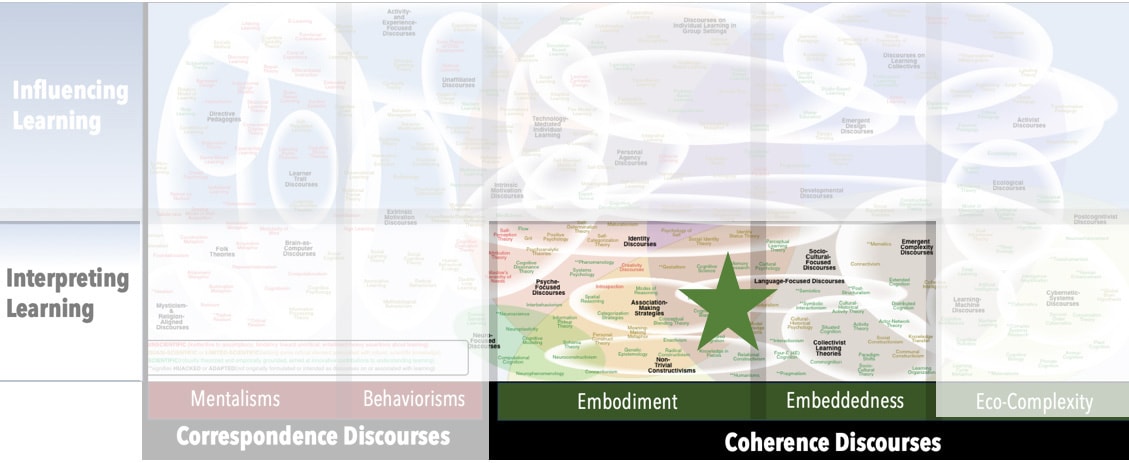AKA
Developmental Learning
Focus
Ongoing production and refinement of meaningPrincipal Metaphors
- Knowledge is … sum of already-established construals/constructs
- Knowing is … personal sense derived from individual experience
- Learner is … a meaning-maker
- Learning is … construing or construction
- Teaching is … supporting sense-making
Originated
1720s / 1960sSynopsis
Non-Trivial Constructivisms encompass a range of learning theories that invoke a “learning as construing” – vs. a “learning as constructing” – metaphor. The construing–constructing distinction is critical, and it became an issue because the French verb construire can be translated as either “to construe” (i.e., to integrate elements to make sense of) or “to construct” (i.e., to build something). Original non-English authors of the theories intended the former, but early English translators opted for the latter – and it stuck. Non-Trivial Constructivisms were among the first Coherence Discourses, and they were explicitly intended as refutations of the assumptions and assertions of Correspondence Discourses (including the “knowledge as object” metaphor that goes along with “learning as construction”). Associated discourses include:- Organization Theory (Organizational Theory of Memory) – (George Armitage Miller, 1950s) – an umbrella category that reaches across those perspectives on learning that suggests it involves the constant organization and reorganization of information in ways that enable recall and interpretive reach. The category is roughly synonymous to Non-Trival Constructivisms.
- Construal – one’s evolving interpretation of associated experiences, often coupled with the Sensemaking Metaphor and/or the Meaning-Making Metaphor. The notion is used as an alternative to “construct” in a deliberate effort to detach from building-based metaphors.
- Knowing – About a century ago, theorists of learning began to use the gerund knowing instead of the noun knowledge to point to the always evolving, intricately networked, inevitably unique, and necessarily engaged nature of personal knowledge. Knowing was understood to be knitted into one’s being, defining of one’s identity.
- Source of Conviction – an underlying reason, evidence, or experience that gives one strong confidence in a belief, memory, or perception. Within formal education, the hope is that learners’ Sources of Conviction will include, for example, their immediate experiences and the authority of experts. However, educators must also be mindful of some other Sources of Conviction that can frustrate efforts to prompt learning, such as:
- Confabulation – a false memory that one genuinely believes to be true, although not created with intent to deceive. A Confabulation may be due to brain damage or cognitive impairment.
- Delusion – a strongly held false belief resistant to contrary evidence, typically linked to mental disorders like schizophrenia
- Dogma – a rigid set of beliefs accepted unquestioningly, usually tied to religion, ideology, or authority. Unlike a Delusion, Dogma is socially reinforced.
-
Hallucination – a sensory perception (sight, sound, touch, etc.) without an external stimulus, often due to mental illness, drug, or neurological condition
- Illusion – a misperception of a sensory event, often due to perspective, lighting, or context
- Apperception (diffuse and centuries old; Johann Friedrich Herbart offered a coherent explication in the early 1800s) – conscious awareness of perception – that is, the process of assimilating a new perception with what one has already learned. Associated constructs include:
- Apperceptive Mass – all that one has already learned, and with which any new perception must fit if it is to be understood – which means that one’s Apperceptive Mass both frames what one is able to perceive and constrains what one is able to learn
Commentary
The biggest problem with Non-Trivial Constructivisms is that the term “Constructivism” is commonly used to refer to theories that are flatly contradictory. Most formal versions are Coherence Discourses, but some are Correspondence Discourses. To further complicate matters, most are strictly theories of learning, but some focus mainly on teaching. Often critics are unaware of this breadth of interpretation, and criticisms can thus be shallow or misdirected. That point in mind, the two most common accusations against Non-Trivial Constructivisms are that they may be solipsistic (i.e., aligned with the notion that the self is the only thing that exists) and/or relativistic (i.e., aligned with the notion that there are no absolute truths).Subdiscourses:
- Apperception
- Apperceptive Mass
- Confabulation
- Construal
- Delusion
- Dogma
- Hallucination
- Illusion
- Knowing
- Organization Theory (Organizational Theory of Memory)
- Source of Conviction
Map Location

Please cite this article as:
Davis, B., & Francis, K. (2025). “Non-Trivial Constructivisms” in Discourses on Learning in Education. https://learningdiscourses.com.
⇦ Back to Map
⇦ Back to List
